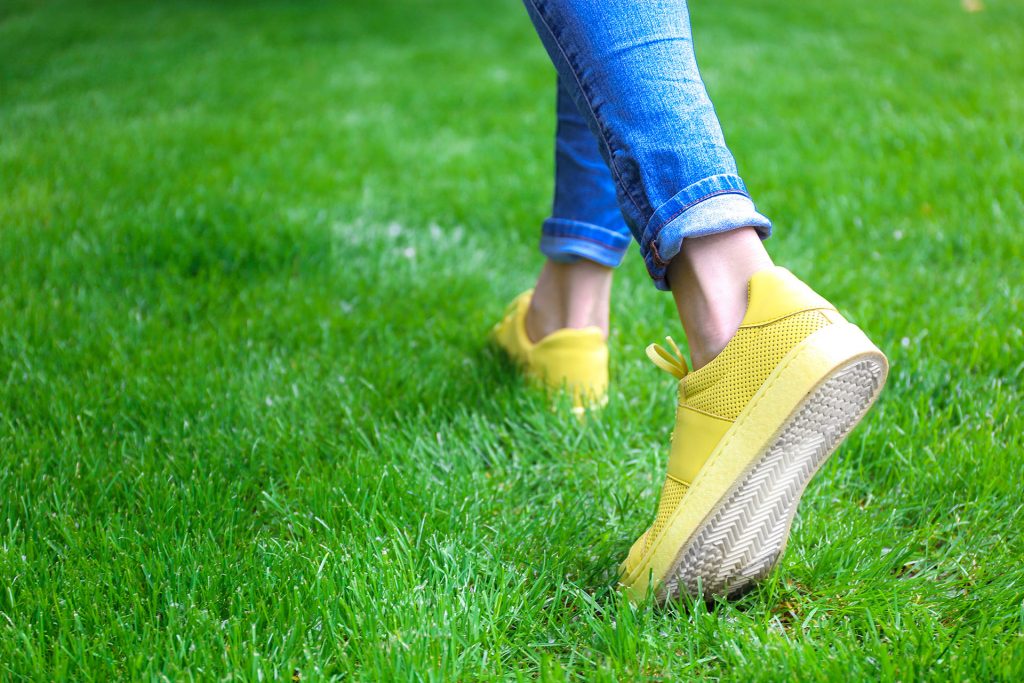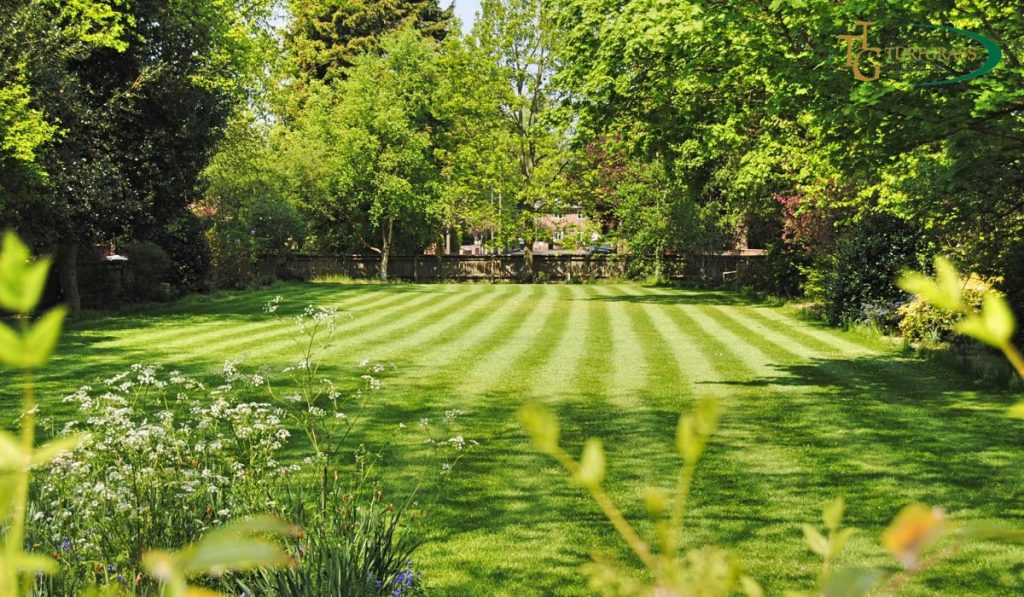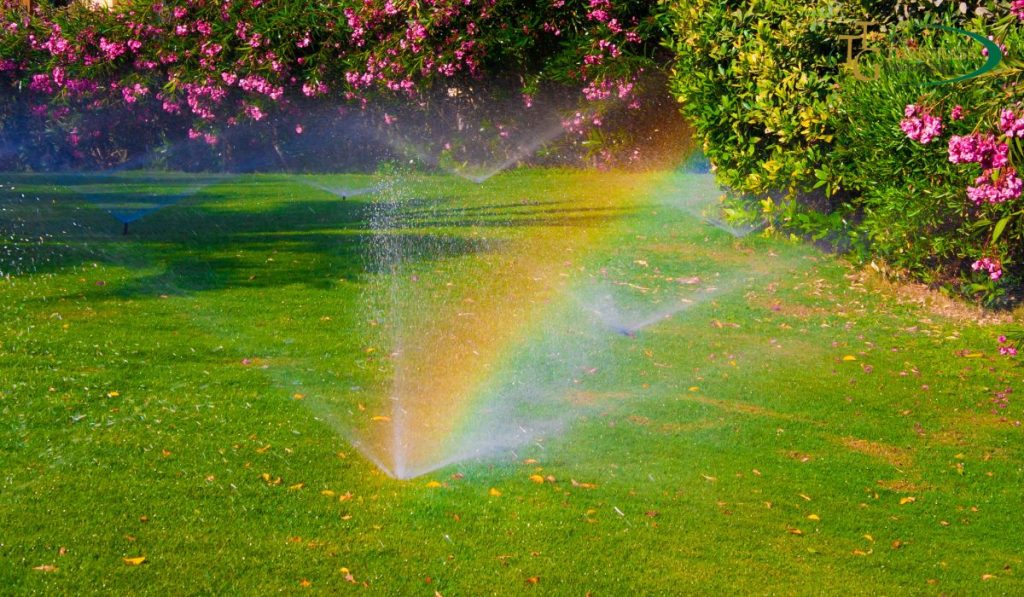
A beautiful, green lawn is the pride of any homeowner.
But what fun is a lawn if you can’t play on it?
Nothing beats the feeling of soft grass under bare feet.
And if you have kids or pets, your property will surely be a go-to play space.
Even if it’s just you, a beautiful lawn makes an excellent location for a barbecue, garden party, and friendly get-together.
But all that summer fun takes a toll on your prized turf.
The more you trample your grass, the harder it is to keep it green.
But that doesn’t mean you can’t grow beautiful grass and enjoy it.
With the proper cultural practices, you can maintain a high-traffic lawn that you can appreciate with your eyes and feet.
What Damages a High-Traffic Lawn?
We all know that the more action your lawn sees, the harder it is to keep it green.
But what precisely is the source of the damage?
Simply stepping on a blade of grass is unlikely to harm it.
Instead, dead grass and bare patches result from more indirect damage.
The most significant consequence of high traffic is how it compacts the soil.
The more feet, tires, or other objects step, roll, or trample across your lawn, the more compressed the ground gets.
With every footfall, the soil is crushed down just a bit.
This collapses the tiny air pockets in your soil.
As the air pockets disappear and the ground becomes denser, it becomes harder for air, water, and roots to penetrate.
Rugged, compact dirt also doesn’t absorb water so that water can pool on the surface and damage plants.
Another problem common to high-traffic lawns is plant and root structure damage.

This is more than just a bent blade of grass.
Heavy traffic can rip up turf and lift roots entirely out of the ground.
This is especially common when the ground is wet, and the seeds can more easily pull out of the soil.
Best Turf for a High-Traffic Lawn
If you have kids or pets or love to entertain, you need a turf variety to keep up with your active lifestyle.
Which turf is best for your lawn depends on your home’s location.
The US is divided into three slightly overlapping growth zones: cool-season, warm-season, and transitional.
The cool-season zone covers the northern states.
The Deep South makes up the warm-season zone.
And the mid-southern states, like Tennessee, Missouri, and the Carolinas, are called the transition zone.
Homeowners in the northern states should stick with Kentucky Bluegrass.
It is lush and durable. It grows well in various environments and stands up to high traffic.
If you live in the Mid-South, consider a variety like Tall Fescue, which grows well in the sun and partial shade.
It is also remarkably well adapted to heat and drought.
It can handle lots of foot traffic and heavy use.
Nothing beats Zoysia grass or Bermuda grass for a high-traffic lawn in the Deep South.
Both varieties are hardy and well adapted for the warm southern summers.
Zoysia grass is ideal for properties with partial shade, where it performs better than many other varieties.
Bermuda grass is perfect for sunny lawns that see lots of heavy use.
It proliferates and can fill bare spots left by too many trampling feet.
Avoid Compacted Soil
The most common source of damage to high-traffic areas is compacted soil.
So, to keep the grass in your high-traffic areas healthy, you’ll need to ensure the soil stays loose.
The best way to do this is to aerate annually, if not twice.
Use a plug or core aerator that pulls out small plugs of dirt from your lawn.
The holes allow air, water, and nutrients like fertilizer to penetrate the soil and reach the turf roots more directly.
After aerating, you will have lots of holes in your lawn.
That’s ok.
If you aerate at the beginning of the growing season, follow up with your semi-annual fertilizer application.
If you do it at the end of the growing season, you can follow up with some high-quality compost, manure, or other organic material.
Mowing and Watering to Reduce Damage
If you have a lawn with lots of use and foot traffic, you can also change your lawn maintenance schedule to help protect your grass.
First, keep the grass as tall as you can.
The exact height varies by the variety of turf you grow, but keeping the blades long provides more padding under each footstep.
TifTuf Bermuda Grass and JaMur Zoysia Grass are great for busy home lawns.
These two varieties, available exclusively from The Turfgrass Group, can be mowed as long as two inches.
Our Zeon Zoysia grass is another excellent home lawn turf that handles partial shade better than other varieties.
It is best to keep Zeon Zoysia at a maximum of one and a half inches.
In addition to keeping your grass long, alternating mowing patterns can keep your high-traffic lawn in good condition.
Avoid following the same path every time you mow to avoid trampling any one area of your property more than necessary.
One of the most fraught times for your lawn is right after watering or after heavy rain.
Grass can easily be torn up when the ground is soaked and your property wrecked.
Try to time your irrigation so the land will be mostly dry when it sees high traffic.
And after heavy rain, try to keep people off your lawn after a heavy rain until the soil has had some time to dry.
If you know you will have a garden party or some other heavy-use event, adjust your watering schedule so your lawn is dry when the party starts.
Alternative Solutions for High-Traffic Areas
Maintaining a patch of lawn that sees regular foot traffic can be a challenge.
Following the guidelines above will help most of your property sustain heavy use.
But if you have an area of your lawn that gets much more traffic than other areas, consider some alternatives.
For example, if part of your lawn is regularly used as a path from one place to another, you’ll find it hard to keep it healthy and lush.
If you have a part of your lawn that you must traverse to reach the entryway to your home, that connects a patio to a sitting area, or that separates any two areas you go to often, it may be best to find an alternative solution.
If a patch of lawn functions as a pathway, treat it like one.
You can install a mulch or gravel walkway to guide people across your lawn.

A walkway solves the problem of maintaining trampled grass and saves the rest of your property by restricting people’s footsteps to a particular area.
If you install gravel or mulch, add metal, rubber, or plastic guides along the path’s edge to keep the course material on the walkway and out of your lawn.
If you want to maintain the look of grass and a fully developed pathway seems too invasive, you can try paving stones.
Installing paving stones in a stepstone pattern lets you grow grass around the rocks but keep trampling feet off your lawn.
Another common problem area is the grass that grows under or around a play structure.
There’s no point trying desperately to keep grass alive as children’s feet trample it daily.
Swing sets are awful for your grass, as dragging feet rip it up daily.
Instead, remove the grass and add recycled rubber playground mulch.
The rubber mulch is soft on little feet and cushions inevitable falls.
It is also a great way to employ recycled materials in your landscaping.
Start With the Right Turf
The best way to handle high traffic on your lawn is to start with the best turf.
JaMur Zoysia grass and TifTuf Bermuda grass are ideal for a high-traffic property.
They grow lush and soft under bare feet and quickly recover from damage.
Zeon Zoysia grass is another great option, especially if parts of your lawn are shaded.
Zeon Zoysia grass is the best option for partial shade and is hardy enough to withstand regular use.
You can find a grower for any of our exclusive varieties here.
Conclusion
A lush, green lawn is a source of pride for homeowners, especially when it’s a space for play, gatherings, and relaxation.
However, maintaining a high-traffic property presents challenges due to soil compaction, root damage, and wear and tear.
Choosing the suitable turf and implementing proper care strategies can help preserve a beautiful lawn that endures heavy use.
FAQs
1. How does high traffic damage a lawn?
High traffic compacts the soil, reducing air pockets necessary for root health and water absorption. It can also physically damage grass and roots, leading to bare patches.
2. What turf types are best for high-traffic lawns?
- Kentucky Bluegrass for northern states.
- Tall Fescue for the Mid-South, resilient to heat and foot traffic.
- Zoysia or Bermuda grass for the Deep South, handling warm climates and heavy use.
3. How can I prevent soil compaction?
Aeration is crucial. Use a plug aerator to create holes that allow air, water, and nutrients to penetrate the soil. Follow up with appropriate fertilization or organic materials.
4. What mowing and watering practices help protect high-traffic lawns?
Keep grass tall for more padding and alternate mowing patterns to avoid constant stress on specific areas. Time watering is necessary to ensure the ground is dry during heavy use.
5. Are there alternatives for highly trafficked areas on a lawn?
Consider creating designated pathways using mulch, gravel, or paving stones to direct foot traffic away from sensitive grass areas. For play structures, recycled rubber mulch provides a durable and safe surface.
6. How can I start with a suitable turf for a high-traffic lawn?
Opt for varieties like JaMur Zoysia, TifTuf Bermuda, or Zeon Zoysia, which are resilient and lush and recover quickly from damage.